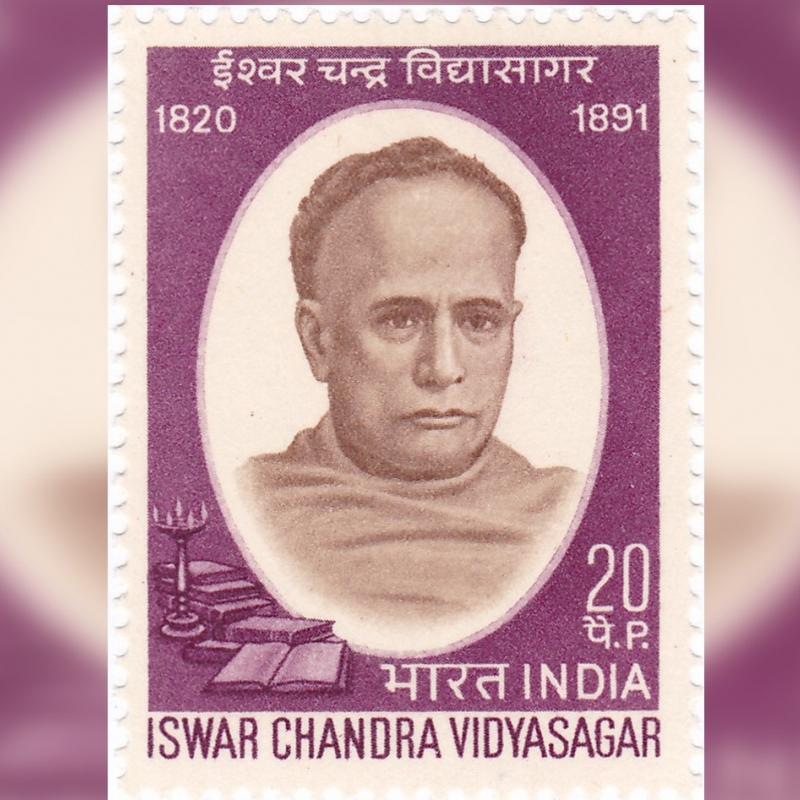Interpreting the life and work of Ishwar Chandra Vidyasagar has often put scholars into ideologically conflicting camps. This especially comes to the fore with respect to his opposition of the Age of Consent Bill of 1891. We attempt to understand Vidyasagar and his ideological concerns. (Photo Courtesy: India Post, Government of India [GODL-India]
Greek mythology speaks of a bandit by the name of Procrustes[i] who lured unsuspecting travellers into seeking shelter with him. He would then lay them down on an iron bed, and once they were asleep proceed to ensure that the height of his guest would conform to the length of the bed. This, he would do in two ways. In the case of an oversized traveller, he would simply amputate the legs and in the case of a shorter person, he would adequately stretch the limbs.
I was reminded of Procrustes and his ways when researching contemporary and later-day scholarly constructions of Ishwar Chandra Vidyasagar (1820–91) and his manifold activities in the field of education and social reform. Most of these, if not all, have attempted to fit Vidyasagar and his work into preconceived frames, determined by differing ideologies. Here, it is important to remember that Procrustes offered an iron bed, which itself could not be altered to fit the size of the guests. Likewise, scholars on Vidyasagar have attempted to use iron-clad theories to fit a man and his work, falling shy of admitting that in many instances, the facts belie a preconceived notion. It is, of course, to Vidyasagar’s credit that he has been able to attract such wide attention, ranging from the conservative writers of his time to the radical critics of the present. But this only makes our understanding of the man and his work more elusive and complex.
Also Read | Recovering Raja Rammohun Roy
Not surprisingly, people with such opposing views have left us with radically different assessments. The conservatives, some of whom were contemporaries or near contemporaries of Vidyasagar, alleged that he deeply hurt the religious and social sentiments of the Hindus by attempting to legalise widow marriages or end polygamous marriages, but wisely compensated for his folly in his old age by opposing the Age of Consent Bill (of 1891) meant to marginally raise the age of consent in India by two years. On the contrary, left-liberal intellectuals, while applauding his reformist zeal in the 1850s and 1860s, accused him of lapsing into regression in 1891. In both cases, evidently, there emerges an ‘early Vidyasagar’ and a ‘later Vidyasagar’, qualitatively set apart in terms of his preferences, passions and strategy. Not surprisingly, these readings are flawed and reductive.
In 1890–91, upper-caste Hindu society was in a state of near revolt when—responding to continued appeals from Hindu social reformers—the British-Indian government decided to raise the age of legal cohabitation from 10 to 12. In part, this was due to the reported death of the child bride Phulmani. She died after forced sexual intercourse by her husband, Hari Maiti, several years older in age. From the orthodox perspective, this bill infringed on the custom of garbhadhan, the customary ritual processes leading to conception in married women. In orthodox Hindu understanding, it was incumbent upon the father that his daughter was married off before she went into her menstrual cycle, failing which he would incur the gravest of sins. Since in Bengali upper-caste society, it was customary to get daughters married between the ages of eight and 10, the proposed amendment was viewed with the greatest consternation. The amendment stipulated that sexual cohabitation with a child bride below the age of 12 would amount to a criminal offence. The orthodox objection here was premised on the belief that a girl commonly had her first menses around the age of nine or 10.
When asked to deliver his legal opinion, Vidyasagar opposed the very idea of fixing the age of consent, arguing that this would bring more harm than good. In substance, his argument was simple: under the proposed amendment, the child bride could be protected only up to the age of 12, beyond which the adult husband would be legally and socially free to indulge in the sexual exploitation of the child-bride. He, therefore, proposed instead that the age of consent be tied to the girl’s first going into menses. In this, he believed that he had the backing of Hindu shastras, which ruled that a husband could sexually cohabit with his wife only post menses.
Also Read | Remembering Iswarchandra Vidyasagar
Modern-day scholars and commentators have seen this to be an instance of Vidyasagar’s backtracking, allegedly in support of the cruel custom of child marriages. At the time, it was widely believed that the amendment, once made into law, would effectively discourage early marriages. From this also resulted the further allegation that Vidyasagar used the shastras to meet a regressive rather than a progressive agenda/objective.
In his defence, however, one needs to state two things. First, the proposed amendment of 1891 was effectively an amendment of the Criminal Procedure Code, which was applicable to all British subjects and not some personal law governing the life of Hindus. It was, thus, that the bill categorically excluded the issue of child marriages from its purview. Second, his consistent use of shastras for advancing the cause of reform was more realistic than opportune, more strategic than regressive.
As early as 1850, when authoring his tract on the evils of child marriages, Vidyasagar had come to realise that neither an appeal to pure reason nor humanitarian compassion would, by themselves, be effective. By comparison, citing Hindu scriptural support might more successfully persuade the orthodox community to accept his arguments, but more importantly, convince the British administration of the moral and legal necessity of enacting a deterrent law.
Also Read | Swami Vivekanand and the 'Woman Question'
Understanding Vidyasagar both in his time and in ours has been considerably swayed by ideological concerns that predisposed people to judge him one way or another, overlooking the underlying spirit or intention behind his agenda or strategy. In 1891, conservative writers misconstrued Vidyasagar’s objections to the bill as a sort of atonement for his previous ‘errors’, on the other hand, those who otherwise read him as being consistently reformist, took this as an instance of his going back on his progressive visions. Arguably, both these camps were acting like Procrustes.
This article was also published on The Wire.
Notes
[i] I was inspired to draw upon the mythology of Procrustes from the writings of Prof. Ramkrishna Bhattacharya.













